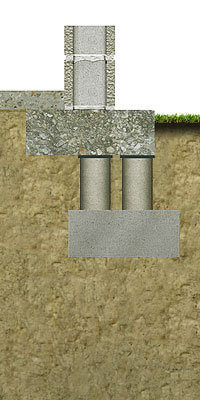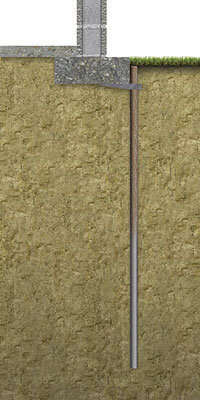Protecting your home – what are today’s best foundation repair methods?
Older technologies and techniques represented the right options for their times. Today, however, if your foundation repair contractor is not using the Cable Lock™ ST Plus System, you (and your home) are “settling” for less than the best.
Foundation repair technology has come a long way in the past few decades. Modern improvements in engineering, materials, and installation methods make foundation restoration more reliable and affordable than ever, but to get the best value, homeowners need to be informed about their options
If you suspect that foundation damage may be lurking beneath your home it’s important to act quickly, as these problems only get worse over time.
Here are six of the most common foundation underpinning methods along with the advantages and disadvantages you should know about when you’re exploring restoration options.
- Concrete Pads – An early repair method was to pour a shallow concrete pad to reinforce the original foundation. These were relatively simple and inexpensive to place in their day, but they don’t contact deeper stable soil and they’re vulnerable to the same settling and shifting that caused the foundation to fail in the first place. For these reasons, concrete pads are unreliable solutions that eat up any initial savings with frequent replacement costs.
- Drilled Piers – One-size-fits-all drilled piers improved on concrete pads by increasing the odds of contacting deeper layers of more stable soil. The downside is that installation is slow, costly, invasive and must be done with expert precision. Any install error can compromise the ability of the pier to support your house. Also, although drilled piers allow soil inspection, installers need to know what they’re looking for to drill to the right depth.
- Driven Steel Piers – An incremental improvement over the drilled pier is a driven steel pier. In addition to faster and cheaper installation, the advantage here is that it’s easier to reach a desirable depth with more confidence and the steel can be load tested to ensure the right support. The risks of this approach are that the steel components may corrode and fail over time and may require breaking out portions of the foundation footer.
- Simple Pressed Pilings – With pressed pilings, soil testing can be accomplished during pile driving, allowing for greater accuracy. Unlike other early foundation repair methods, pressed pilings enable reliable load calculations based on the type of structure they’re supporting. Disadvantages of pressed pilings are that they are not reinforced, buckle easily, and they’re hard to place in complex soil types or below weather-affected soil zones.
- Helical Piers – The helical pier technology breakthrough eliminated several disadvantages of more primitive foundation repair methods. Steel disks at engineered intervals around a core shaft provide greater soil contact, provide both tension and compression support, need no concrete, and offer wide customization options. On the other hand, helical piers are expensive, depth requirements can be hard to confirm, they may buckle or corrode, and install brackets may have fit issues.
- Cable Lock ST Plus – The proprietary Cable Lock™ ST Plus system combines the advantages of piers with the convenience of pilings with greater support and rigidity. The reliability of this system is corrosion resistant, quick and affordable to install, and results in minimal disruption to your property. You can be assured that the support system is contacting stable soil at the right depth, and the reliability allows the installer to offer a lifetime guarantee.
The older foundation restoration technologies we’ve covered here offered the best attainable results for their times. Today, however, if your foundation repair contractor is not using the advanced Cable Lock™ ST Plus system, you’re “settling” for less with less reliable methods that could allow your home to settle, leading to costly foundation damage.
Other Foundation Repair Methods
Click the images below to view the pros & cons of each foundation underpinning method.
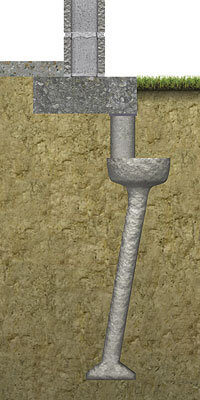
Drilled Piers

Drilled Piers
Advantages
- Adequate solution when properly installed
- Depth can be verified
- Soils can be visually checked
- Concrete can be steel reinforced
Disadvantages
- Most failures caused by improper installations
- Soils are not properly identified
- Takes 2–4 weeks to complete installation
- Can cause expensive loss of plants due to long installation times
- Same design used for all structures
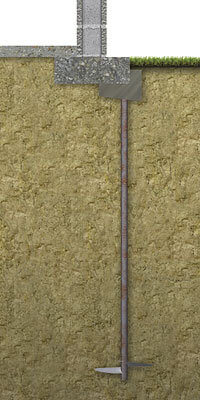
Helical Piers

Helical Piers
Advantages
- Performance in tension and compression allowing for both foundations underpinning and wall anchoring
- No concrete needed
- Wide variety of applications
Disadvantages
- Steel shafts have strength limitations
- Pier buckling
- Load of the structure cannot determine depth requirements
- Corrosive soils can have long–term affects on steel shaft
- Bracket does not always fit
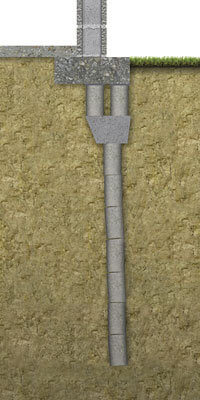
Simple Pressed Pilings

Simple Pressed Pilings
Advantages
- Depth requirement can be determined by load of structure
- Soils are tested during pile driving
- Concrete tested under load it is supporting
- Concrete cylinders allow for a quicker job
Disadvantages
- Problems getting below the weather affected zone in difficult soils and on light structures
- No reinforcement allows buckling

Cable Lock ST Plus

Cable Lock ST Plus
Advantages
- The best solution for foundation repair available today
- Combines the advantage of the bell-bottom pier with the convenience of the pilings
- Support and rigidity of this procedure make it superior to other foundation repair methods currently available
- Reliability allows the installer to give a lifetime guarantee
Disadvantages
- NONE
Searching for more information on different foundation repair methods or Olshan’s own foundation repair process?

